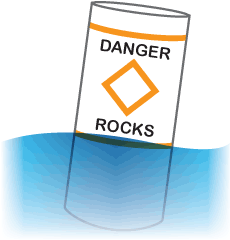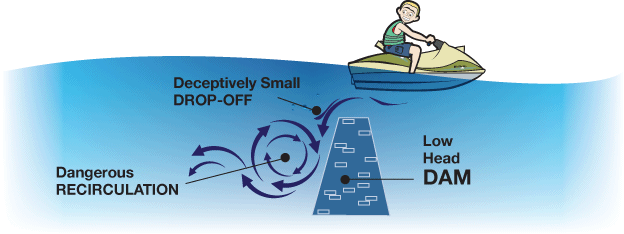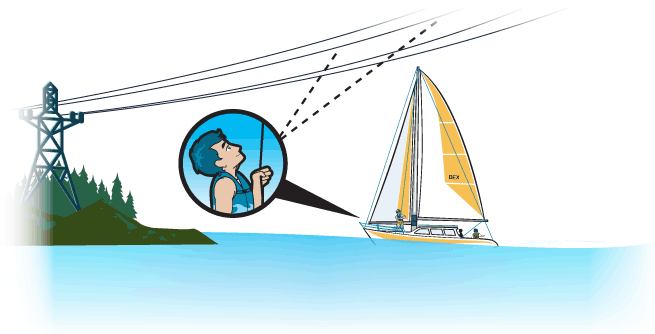Weather Conditions & Navigating Rough Seas
Checking Local Weather and Water Conditions
Before any boating trip, you should check the short-term and long-term local weather forecast as reported on the radio, TV or Internet. You should always factor these weather forecasts into your preparations as you make your trip plan. For example, you'll want to avoid certain types of weather whenever possible, such as heavy fog or strong winds. You'll also want to pay particular attention to hurricane warnings; you should never go boating if there is a hurricane warning in effect.
Once on the water, tune a portable radio to a VHF-FM weather station that broadcasts the National Oceanic and Atmospheric Administration (NOAA) to get accurate, detailed and up-to-date weather information. N-O-A-A Weather Radio is frequently updated and covers the coastal areas of continental United States, Alaska, Hawaii, and the Mariana Islands with continuous weather broadcasts. It's your best resource for weather information while on the water. You'll find the NOAA broadcasts on the following frequencies:
| WX1 | WX2 | WX3 |
|---|---|---|
| 162.550 MHz | 162.400 MHz | 162.475 MHz |
These broadcasts include weather information like temperature, humidity, wave conditions, barometric pressure, as well as wind speed and direction--- all important factors for determining when and where to boat, and when to head for shore.
Monitor Weather While on the Water
Since the weather can change very quickly, particularly when you're out on the water, it is vital that you pay close attention to weather forecasts and anticipate weather changes whenever possible.
Here are some tips for keeping on top of weather changes while out on the water:
- Always keep an eye to the sky. Fog, dark clouds and lightning are clear signs that bad weather is approaching.
- Monitor barometric readings. A rising barometer is a sign that good weather is coming while a falling barometer indicates that foul weather is likely.
- Pay close attention to shifts in the wind direction and temperature; these are signs that the weather is changing.
- Be mindful of the West as bad weather usually approaches from this direction. Storms from the East often pack quite a wallop.
- Continually monitor your radio and weather channels and ask for information about local weather patterns by radio, especially if you're in unfamiliar waters.
Finally, take note of what other boaters are doing. If they're heading for shore, it can give you a heads up about coming weather changes.
Boating in Rough Water
If you're out on the water and a storm is heading your way, you should prepare yourself, your passengers and your boat by taking the following steps:
- Make sure that everyone on board is wearing a lifejacket and that it is secured properly.
- Reduce your speed and continue with caution, keeping an eye out for other boats and floating debris.
- Close all hatches and ports to avoid swamping.
- For stability and safety, get your passengers to stay low in the boat near the centerline.
- Secure any loose items to avoid losing them overboard.
- Pump out the bilges so that your boat sits higher in the water.
- Check marine charts to find the nearest shelter, noting any hazards in the area;
- And proceed cautiously to the nearest safe shoreline.
If a storm has already hit, here are some additional tips to ensure the safety of everyone on board:
- If there is lightning, unplug all electrical equipment. Stay low in the boat and away from metal objects.
- Head the bow of the boat into waves at a 45-degree angle. This will keep the boat in the most stable position.
- If your engine stops, drop an anchor from the bow to combat drifting and swamping. Never drop anchor from the stern.

Remember, whenever you are boating in stormy weather, your first step is to make sure that all persons on board are wearing United States Coast Guard-approved personal flotation devices.
Checking Local Hazards: Obtain Weather Forecast Information

It's important to learn about local hazards before going boating in any new or unfamiliar waters. You can do this by obtaining local marine charts and/or checking with local boaters and marinas.
Local boaters and marinas typically have a wealth of knowledge about boating in their area and are usually more than happy to share it.
You should also find out if there are local rules such as horsepower restrictions, hours of operation, or access to locking operations that could impact your trip.
Now let's review some of the hazards that you'll want to be aware of when boating.
Local Hazards to be Wary of:
Whitewater Areas
Whitewater areas can very easily drag a boat or person downstream. Rocks, debris, as well as a strong, rushing current, are some of the dangers of whitewater.
Shoaling Areas
Shoaling areas (marked and unmarked) become shallow gradually and are often difficult to spot without local charts.
Hazardous Inlets
Hazardous inlets can produce abnormal currents or changes in water levels.
Abnormal Tides or Currents
Abnormal tides or currents can affect your ability to properly navigate or steer your vessel.
Low-Head Dams
Low-head dams pose a hazard both below and above the dam. Small vessels, objects and people can get trapped in the hydraulic 'hole' at the base of these dams, creating a dangerous situation. Always be on the lookout for warning signs or buoys indicating low-head dams.
Note: Low-head dams are especially hazardous to paddle craft. If you are paddling near a low-head dam, always try to avoid it, or portage your boat and its cargo overland around the dam. Getting trapped in a low-head dam can be fatal. Keep a sharp lookout and avoid them!

Powerlines
Powerlines pose a particular hazard for sailing vessels, or any vessel with a mast. Make sure that your vessel has enough clearance to safely pass beneath any powerlines, and if you are unsure, don't take the risk.

Low Seasonal Waters
Low seasonal waters do not appear on local charts, which show only the average water level. You'll want to keep in mind that waters are generally higher in the spring and lower in the summer. Make adjustments for low seasonal waters, as they make it more likely for your boat to run aground.
Obstructions
Pay extra attention to obstructions such as bridges, channel openings and commercial fishing nets. When you are close to these types of obstructions, proceed with caution.
Low-head dams are difficult to detect downstream.
